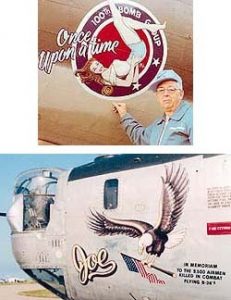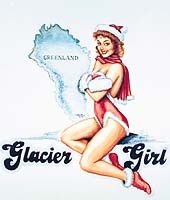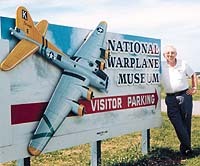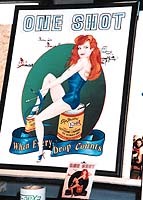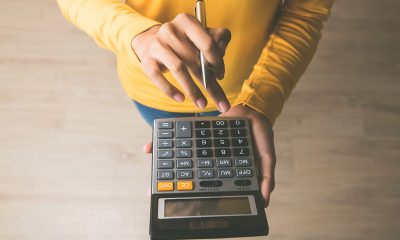Standing outdoors in a "bomb dump" and surrounded by explosives, he painted "No Cigarettes" signs. When bulletin colors weren’t available, he hand-mixed house-paint with oils. Good sable was hard to come by, so he used blunt, coarse Delta and Grumbacher quills with "U.S. Air Force" stamped on the handles. Indeed, Owen Hughes’ (Newark, NY) sign-making experiences during WWII were far different than those of today’s vinyl retailers.
A native of Fremont, OH, Hughes was assigned to the Air Devil Group, a division in Burtonwood, England, that made modifications to airplanes during the war. He and the five men he oversaw were dubbed "barn (airplane-hangar) painters," because no military designation existed for sign-makers. Hughes says that typically, a barn painter could only achieve a private-first-class ranking. He, however, was named a corporal, and eventually earned a staff-sergeant title.
In addition to painting airplane-hangar doors, Hughes and his men created warning signs — "No Trespassing," "Restricted Area" and the like. Hughes also rendered murals in military bars. For an enlisted men’s bar, he was asked to paint skylines depicting New York and San Francisco. Folks at an officers’ bar, though, wielded spicier tastes: They wanted portraits of pin-up girls.
Hughes was well equipped to paint "well-equipped" women. Before the war, he had designed, painted, built and installed billboards for an outdoor-advertising firm in Fremont. Plus, during the war, he logged many hours painting "nose art" for pilots. Pilots frequently landed their planes at the airfield where Hughes was stationed. In the evenings, after completing his sign-making duties, Hughes voluntarily painted voluptuous women and cartoons on their planes. His superiors didn’t mind his extra painting duties; they knew the nose art served as a valuable morale booster.
Often, says Hughes, pilots had movie stars or girlfriends in mind as nose-art subjects; the soldiers supplied him with magazines or photos to use as reference. Sometimes though, Hughes was given free reign. He recounts one occasion where the crew of a B-17 asked him to paint nose art, but had no female subject in mind. Hughes opted to paint singer Lena Horn, since he had an attractive image of her. Despite the prejudice against African-Americans at the time, the crew was pleased with Hughes’ selection. "It was a pretty girl, so they didn’t mind," he says.
When painting nose art, Hughes didn’t have airbrushes or other modern implements with which to work. Although the airbrush had recently been invented, it was not widely used. In fact, he had only military-issued brushes on-hand, which he describes as the "worst in the world." Blending paints thus proved challenging. A traditionalist, Hughes says, "I cringe when I see airbrushed pin-up girls today, because it isn’t right."
Lacquer paint — used to paint planes — was readily available during WWII. But, because lacquer dries so quickly, it could not be used for sign work and art. Similarly, oils couldn’t be used because they take so long to dry. Bulletin colors were the paint of choice, but when they were in short supply, Hughes improvised: He purchased house paint in town, and mixed it with oils. "Flattening" paints also required a little ingenuity; urine proved to be a popular mixing agent.
In addition to painting art, Hughes also hand-lettered each plane’s name. The lettering was more than decorative; it served a practical purpose. Other than the military-issued numbers on the side of a plane, the lettered name was the only way in which a vehicle could be identified.
Hughes had only a limited window of time in which to complete a plane’s nose art — from 6 p.m. until sunset. As such, he had to work rapidly, sometimes using a flashlight to finish his job.
The "going rate" for WWII nose art was $10. But Hughes never accepted cash for his work. He preferred a modified barter system. Because he loved to fly, he traded nose art for airplane rides.
After the war, Hughes worked for several sign companies in the states, performed screen-printing work, created convention displays and designed food cartons. Although he officially retired at age 62, he has spent the last 18 years doing freelance sign work and painting planes and nose art. In fact, he has been commissioned to paint a space-shuttle painting for a NASA astronaut.
When painting planes, Hughes is meticulous about authenticity. "I love detail. The more detail I can get in, the better. People who know planes will know if it’s not accurate." But when it comes to pin-up girls, he exercises artistic license: "All my girls are from my imagination. And I have a pretty active imagination. My wife is my worst or best critic. She tells me when I’ve got things out of place."
Letterhead Meets new products
It’s been eight years since Letterheads first paved the way to Jack Lindenberger’s Evansville, IN-based Creative Signs. At the eighth-annual conclave, March 26-28, more than 50 ‘heads converged to paint, drink and be merry.
As always, one of the meet’s highlights included a contest for the fastest pinstriper. Although the competition was divided by gender, the fastest pinstriping female scored only slightly lower (7.06 seconds) than the fastest-striping male (6.29 seconds). Mike Contreras, Kid Kustoms, Wyoming, MI, took top honors in the male competition, followed by Steve Connor, Con-Man Painting, Odell, IL, (6.44 seconds) and Doc Welty, Southern Signworks, Paoli, IN (6.9 seconds). In the women’s group, Theresa Lardi, who came with Steve Conner, pulled the quickest stripe, followed by Linda Nims, Art and Lettering, Dickson, KY (8.03 seconds) and Denise Carson, Meyer Signs, Mazeppa, MN (8.15 seconds).
When not striping, however, attendees listened to a varied musical selection while painting many types of signage. William J. Krupinski, a sign "wizard" in Jefferson, WI, designed four banners for the upcoming International Meet in Mazeppa; several Letterheads painted and airbrushed pin-up girl posters for an upcoming 1-Shot calendar; and everybody found creative ways to incorporate the number "8" into panels.
New Commercial Sign-Making Products 1-Shot LLC, Gary, IN, announces four lettering-enamel colors, a topcoat and a hardener. Call (219) 949-1612.
The |2407|, Cleveland, announces a line of awning, woven and vinyl fabric and non-porous surface cleaners and protectants under the Astrup name. Call (216) 696-2820.
Andrew Mack & Son Brush Co., Jonesville, MI, offers three products named after the brush’s designer. Call (517) 849-9272.
|2426|, Union, NJ, adds the PreView® line of application films to its PerfectTear® line of paper application tapes. Call (732) 345-7415 or (800) 338-7350.
Northport WoodSmiths, Northport, NY, introduces a ready-to-install sign kit. Call (516) 757-5655.
Quality Manufacturing Inc., St. Paul, MN, introduces Vinyl-EEZ™ graphic application fluid. Call (651) 483-5473 or (800) 243-5473.Astrup Co. Main Tape


 Tip Sheet4 days ago
Tip Sheet4 days ago
 Business Management2 weeks ago
Business Management2 weeks ago
 Women in Signs2 weeks ago
Women in Signs2 weeks ago
 Real Deal5 days ago
Real Deal5 days ago
 Benchmarks1 day ago
Benchmarks1 day ago
 Editor's Note1 week ago
Editor's Note1 week ago
 Line Time2 weeks ago
Line Time2 weeks ago
 Product Buying + Technology1 week ago
Product Buying + Technology1 week ago
